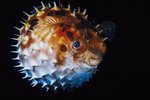Most people had never heard of the blobfish until September 2013 when it was named the world’s ugliest animal. The creature’s unusual appearance caused some concern, including questions of whether this fish could bite. Thankfully, the blobfish poses little threat to humans. Not only does it lack teeth for biting but few humans will ever come in contact with a living specimen.
Home of the Blobfish
Blobfish make their homes deep in the waters around Australia and Tasmania. They typically can be found between 2,000 and 3,900 feet below the surface of the ocean. Human beings don't go deeper than 1,000 feet into the ocean so they never come into direct contact with the blobfish. The reason for this distance is not because of the blobfish have a scary reputation but that at the depths it calls home the pressure exerted on the body by the water would be more than 900 psi. Pressure that great would crush the human body.
Blobfish: The Lazy Ambush Predator
While the blobfish does have a reputation as an ambush predator, it did not earn that classification by creating traps for unsuspecting prey or other diabolical behavior. Instead, the blobfish just floats and waits for passing creatures and organic debris then it opens its mouth, sucks in the nearby food source and swallows. In this sense, the blobfish is really just a marine version of a couch potato waiting for its food to be delivered by the water. Also, since the blobfish swallows its food, little to no chewing is required so the creature does not need the types of teeth seen in the fangtooth, piranha or other scary marine creatures.
Like a Bowl of Gelatinous Matter
Blobfish look gelatinous in pictures because that is an adaptation that helps it survives in deep water. They do not have any muscles so their body literally appears as a blob. Because of the immense pressure exerted on its body by the water, blobfish muscles would not be able to survive. Another adaptation that allows it to survive is its lack of a gas bladder. Most fish use their gas bladders to stay afloat in the water, but such an organ would not be useful at those depths. Instead, the jelly-like body allows the blobfish to stay buoyant without the bladder. This lack of muscles and bladder also mean blobfish cannot chase down a human trying to escape so even if its unusual, sad-looking face could bite, chances are good most humans could easily get away.
Blobfish Should Fear Humans; Not the Reverse
Even though it lives deep in the ocean, the blobfish faces possible extinction because of human behaviors. Deep trawling vessels accidentally catch blobfish occasionally in their nets; hence, the only reason humans learned of their existence. As this becomes increasingly common, the blobfish population is likely to decline. In fact, no one has a clear idea of how many blobfish exist. The ugliest animal contest won by the blobfish was intended to raise awareness of this threat to the creature’s continued existence.
References
- Christian Science Monitor: Move Over Blobfish, the Fangtooth is Scarier
- Discovery: The Blobfish
- YouTube.com: Psychrolutes Marcidus
- Huffington Post: Blobfish Voted World's Ugliest Animal
- YouTube.com: Amy's Animal Facts: Blobfish
- Unusual Creatures: Blobfish
- UK Mail News: World's Most Miserable Looking Fish in Danger of Being Wiped Out
Writer Bio
Amy Jorgensen has ghostwritten more than 100 articles and books on raising and training animals. She is also an amateur dog trainer. She has also written more than 200 blog posts, articles, and ebooks on wedding and party planning on behalf of professionals in the field.





